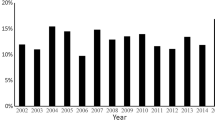Abstract
In children with fulminant myocarditis (FM), we sought to describe presenting characteristics and clinical outcomes, and identify risk factors for cardiac arrest and mechanical circulatory support (MCS). A retrospective review of patients with FM admitted at our institution between January 1, 2004, and June 31, 2015, was performed. We compared characteristics and outcomes of FM patients who received cardiopulmonary resuscitation (CPR) and/or were placed on MCS (CPR/MCS group) to those who did not develop these outcomes (Control group). There were 28 patients who met criteria for FM. Median age was 1.2 years (1 day–17 years). Recovery of myocardial function occurred in 13 patients (46%); 6 (21%) had chronic ventricular dysfunction, 6 (21%) underwent heart transplantation, and 3 (11%) died prior to hospital discharge (including one death following heart transplant). Of the 28 FM patients, 13 (46%) developed cardiac arrest (n = 11) and/or received MCS (n = 8). When compared to controls, patients in the CPR/MCS group had a higher peak b-type natriuretic peptide (BNP) levels (p = 0.03) and peak inotropic scores (p = 0.02). No significant differences were found between groups in demographics; chest radiograph, electrocardiogram, or echocardiogram findings; or initial laboratory values including BNP, troponin, C-reactive protein, lactate, and creatinine (p > 0.05 for all). Children with FM are at high risk of cardiovascular collapse leading to the use of CPR or MCS. Aside from peak BNP levels and inotropic scores, the most presenting characteristics were not helpful for predicting these outcomes. FM patients should ideally receive care in centers that provide emergent MCS.


Similar content being viewed by others
References
Freedman SB, Haladyn JK, Floh A, Kirsh JA, Taylor G, Thull-Freedman J (2007) Pediatric myocarditis: emergency department clinical findings and diagnostic evaluation. Pediatrics 120:1278–1285
Amabile N, Fraisse A, Bouvenot J, Chetaille P, Ovaert C (2006) Outcome of acute fulminant myocarditis in children. Heart 92:1269–1273
McCarthy RE 3rd, Boehmer JP, Hruban RH, Hutchins GM, Kasper EK, Hare JM, Baughman KL (2000) Long-term outcome of fulminant myocarditis as compared with acute (nonfulminant) myocarditis. N Engl J Med 342:690–695
Duncan BW, Bohn DJ, Atz AM, French JW, Laussen PC, Wessel DL (2001) Mechanical circulatory support for the treatment of children with acute fulminant myocarditis. J Thorac Cardiovasc Surg 122:440–448
Nahum E, Dagan O, Lev A, Shukrun G, Amir G, Frenkel G, Katz J, Michel B, Birk E (2010) Favorable outcome of pediatric fulminant myocarditis supported by extracorporeal membranous oxygenation. Pediatr Cardiol 31:1059–1063
Rajagopal SK, Almond CS, Laussen PC, Rycus PT, Wypij D, Thiagarajan RR (2010) Extracorporeal membrane oxygenation for the support of infants, children, and young adults with acute myocarditis: a review of the Extracorporeal Life Support Organization registry. Crit Care Med 38:382–387
Wernovsky G, Wypij D, Jonas RA, Mayer JE Jr, Hanley FL, Hickey PR, Walsh AZ, Chang AC, Castaneda AR, Newburger JW, Wessel DL (1995) Postoperative course and hemodynamic profile after the arterial switch operation in neonates and infants. A comparison of low-flow cardiopulmonary bypass and circulatory arrest. Circulation 92:2226–2235
Miyake CY, Teele SA, Chen L, Motonaga KS, Dubin AM, Balasubramanian S, Balise RR, Rosenthal DN, Alexander ME, Walsh EP, Mah DY (2014) In-hospital arrhythmia development and outcomes in pediatric patients with acute myocarditis. Am J Cardiol 113:535–540
Teele SA, Allan CK, Laussen PC, Newburger JW, Gauvreau K, Thiagarajan RR (2011) Management and outcomes in pediatric patients presenting with acute fulminant myocarditis. J Pediatr 158(4):638–643
Tschope C, Bock CT, Kasner M, Noutsias M, Westermann D, Schwimmbeck PL, Pauschinger M, Poller WC, Kuhl U, Kandolf R, Schultheiss HP (2005) High prevalence of cardiac parvovirus B19 infection in patients with isolated left ventricular diastolic dysfunction. Circulation 111:879–886
Kuhl U, Pauschinger M, Bock T, Klingel K, Schwimmbeck CP, Seeberg B, Krautwurm L, Poller W, Schultheiss HP, Kandolf R (2003) Parvovirus B19 infection mimicking acute myocardial infarction. Circulation 108:945–950
Vigneswaran TV, Brown JR, Breuer J, Burch M (2016) Parvovirus B19 myocarditis in children: an observational study. Arch Dis Child 101:177–180
Molina KM, Garcia X, Denfield SW, Fan Y, Morrow WR, Towbin JA, Frazier EA, Nelson DP (2013) Parvovirus B19 myocarditis causes significant morbidity and mortality in children. Pediatr Cardiol 34:390–397
Wolf GK, Frakes MA, Gallagher M, Allan CK, Wedel SK (2010) Management of suspected myocarditis during critical-care transport. Pediatr Emerg Care 26:512–517
Wilmot I, Morales DL, Price JF, Rossano JW, Kim JJ, Decker JA, McGarry MC, Denfield SW, Dreyer WJ, Towbin JA, Jefferies JL (2011) Effectiveness of mechanical circulatory support in children with acute fulminant and persistent myocarditis. J Card Fail 17:487–494
Acknowledgements
Dr. Costello’s efforts on this project were supported in part by an endowment given to the Division of Cardiology at Ann & Robert H. Lurie Children’s Hospital of Chicago by Mr. Warren Batts. Dr. Mazwi’s effort was supported in part by the Ginsburg family.
Author information
Authors and Affiliations
Corresponding author
Rights and permissions
About this article
Cite this article
Casadonte, J.R., Mazwi, M.L., Gambetta, K.E. et al. Risk Factors for Cardiac Arrest or Mechanical Circulatory Support in Children with Fulminant Myocarditis. Pediatr Cardiol 38, 128–134 (2017). https://doi.org/10.1007/s00246-016-1493-5
Received:
Accepted:
Published:
Issue Date:
DOI: https://doi.org/10.1007/s00246-016-1493-5




